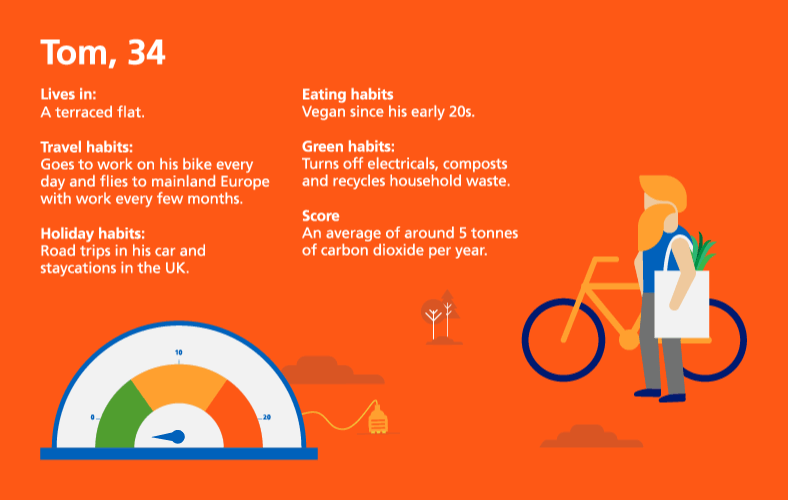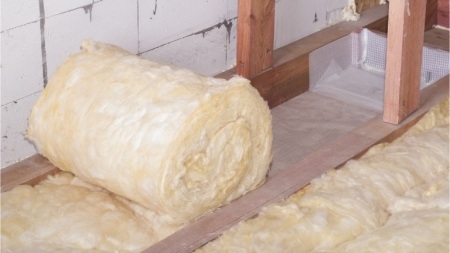
Carbon footprints: what makes them high or low?
Are you trying to be more low-carbon? Your lifestyle, what you eat, how you travel and your home all play a part in how much you impact the earth. And the activities that make your carbon footprint higher can be quite surprising.
The average person in the UK has a carbon footprint of around 10 tonnes per year(1), which would fill about 24 million balloons(2).
We interviewed three people to demonstrate what can make a carbon footprint high or low.
Keeping your lifestyle low carbon

Unsurprisingly, Tom’s carbon footprint is quite small and below the national average.
His proactive, responsible attitude to low-carbon living makes a big difference to the amount of carbon his lifestyle uses. However, his reliance on air travel for work shows significantly in his results, inflating his score.
What drives your carbon footprint up


Because Danielle needs her car to get around and has to fly for work, she finds it difficult to be green. Her reliance on fossil fuels for commuting and working abroad means that her carbon footprint score is above the UK average. She could bring this down by carpooling or using public transport rather than commuting in her car. If Danielle switched her petrol car to an electric car she’d also see an improvement on her score.
She could also reduce her carbon footprint by thinking about how her family use energy at home. Turning off TVs and other standby appliances at the plug and eating less meat would all help to reduce her impact on the earth. Getting a smart meter could help with this.
How to make the lowest carbon impact

Laura’s carbon footprint is the lowest. There are many reasons for Laura's low-carbon footprint, the biggest is her lack of air travel and the fact she is very conscious of her home energy tariff.
Her love of cooking reduces her carbon footprint further – as she’s not getting takeaways and reducing, reusing and recycling as much as possible.
Low-carbon tips and tricks
Want to know how you can be more energy efficient at home? You can check out our energy efficiency tips and tricks.
Read energy saving tips
Low-carbon energy
We’re the UK’s biggest producers of low-carbon energy. Why not take a look at the range of tariffs we offer? From tariffs that cover your boiler to tariffs that include smart tech.
Low-carbon travel
We now offer a range of electric car options – from our stand-alone EV tariff all the way up to our complete option that includes our tariff, charger and an electric car lease.

How to reduce your carbon footprint and live low carbon
We’ve all got a part to play in helping Britain achieve Net Zero, but what does that look like in our day-to-day lives?
Your lifestyle, what you eat, how you travel and your home all play a part in how much you impact the earth. Everything you do has a carbon footprint, and there are probably things making yours higher than you realise.
What is my carbon footprint?
Your carbon footprint is the total amount of emissions generated by your everyday life. It's generally calculated over a year and is based on the activities you do (like flying, driving, etc.), as well as the manufacture, use and disposal of all the products and resources you use (like food, laptops, mobile phones, etc).
What's an average UK carbon footprint?
The average person in the UK has a carbon footprint of around 10–13 tonnes per year. That’s enough to fill roughly 24 million balloons and, to offset it, you’d need to plant 500 trees. But do you know what makes up all those tonnes?
To give you an idea we interviewed three people with three distinct lifestyles and working patterns to show you what goes into your carbon footprint. We want to show you what can make your footprint high or low, and give you some ideas for ways to reduce your day-to-day emissions.
Meet Tom, 34:

Keeping your lifestyle low carbon
- Lives in a: terraced flat
- Travel habits: mostly works from home, but cycles to the office 2 days a week. Used to fly to mainland Europe every few months for meetings
- Holiday habits: road trips and staycations in the UK
- Eating habits: vegan since his early 20s
- Green Habits: turns off electrical items at the wall, composts, recycles household waste
- Score: Average 5 tonnes of C02 a year
Unsurprisingly, Tom’s footprint is pretty low, and well below the national average. Cycling to work, eating a vegan diet and holidays in the UK are all proactive ways of keeping your emissions down and living a low carbon lifestyle.
How Tom could lower their carbon footprint
All that air travel for work bumps up Tom's average yearly emissions. Three return trips to the head office in Paris clock in at nearly a tonne of carbon. Getting the train could reduce these emissions by up to 90% - a change worth making! Due to the pandemic, these regular flights have been switched to Zoom calls which has saved the business money and reduced Tom's carbon footprint.
Meet Danielle, 46:

What’s driving your carbon footprint up?
- Lives in a: semi-detached house
- Travel habits: drives a 4x4 to do the school run and run errands like grocery shopping at a big supermarket out of town
- Holiday habits: travels to Dubai twice a year for work and takes a long-haul family holiday every year
- Eating habits: eats meat most days and doesn’t recycle much
- Green Habits: insulated the loft and got energy efficient light bulbs
- Score: Averages 19 tonnes of C02 a year
Danielle’s reliance on their car for the school run and everyday errands, as well as flying for work means a carbon footprint that’s well above average. Plus a diet that includes a lot of meat and little to no recycling means they could be generating nearly 4x the emissions of our friend Tom.
How Danielle could lower their carbon footprint
One way to lower their emissions would be to set up a car share or lift share for the school run with other parents. Getting together and taking turns means fewer cars on the road and fewer emissions (and could free up time in the morning to go grocery shopping locally instead of heading to the big out-of-town supermarket).
Danielle's business trips have been reduced and replaced recently due to the pandemic, with business meetings replaced with Zoom calls. This has severely reduced her carbon footprint.
If a car is essential though Danielle could consider switching to an EV. Research has shown that electric cars are better for the environment as they emit fewer greenhouse gases and air pollutants than petrol or diesel cars. Plus you can charge your EV with 100% zero carbon renewable electricity with EDFs GoElectric tariff.
Danielle could also be saving at home by thinking about how her family use energy. The Energy Saving Trust estimates that Brits could save £1.7 billion a year by switching their devices off at the wall – that’s a saving of at least £35 a year on your bills.
Additionally, Danielle could make additional savings by making sure her insulation is up to scratch. You can save up to £580 on bills each year and prevent 25% of your heat loss through your roof. Loft insulation is an easy and effective way to reduce your heating bills. Installed correctly it should pay many times over in its 40-year lifetime.(3)
Cutting out meat is another way to live low carbon - by going vegetarian your food-related emissions could be cut in half. Not quite ready for that? Why not try Meat-Free Mondays instead?
Meet Laura, 22:

How can I reduce my carbon footprint?
- Lives in a: a two-bed flatshare
- Travel habits: cycles or walks to work (when she's not working from home)
- Holiday habits: nervous flyer so opts for ferry or train holidays
- Eating habits: vegetarian
- Green Habits: avoids single-use plastics, recycles, eats local produce
- Score: Averages 3 tonnes of C02 a year
Laura’s carbon footprint is by far the lowest, largely due to the fact that they opt for rail or ferry holidays rather than flying. Plus by cooking local vegetarian produce at home and avoiding takeaways, they’re reducing packaging and plastics that can’t be recycled, as well as reusing and recycling as much as possible.
Tips on how to reduce your carbon footprint
Want to know how you can be more energy efficient at home? Check out our energy efficiency tips and tricks to see where you could be cutting carbon and saving on your energy bills. From low carbon heating, energy and appliances there’s plenty to try. Here's a taster;
- Turning your heating down by one degree could save you up to £80 a year and lower your emissions
- Closing the curtains will keep the heat in during winter - just don't drape them over the radiators
- LED lightbulbs can save you energy, and last up to ten times longer than normal bulbs
Zero carbon electricity
We’re the UK’s biggest generator of zero carbon electricity(4) and we’re proud to be doing our bit to help Britain achieve Net Zero. Want to join us? Get a quote today.
Get EVerything you need to drive electric
Visit our electric cars hub for leasing deals, EV tariffs and home charging points.
Related articles

What you need to know about the planned RTS meter shutdown

ECO+ scheme to help more customers insulate their homes in 2023
